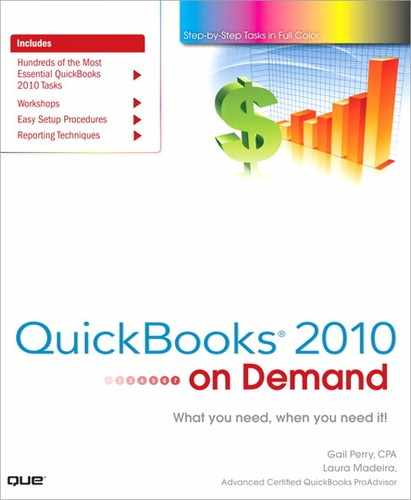9. Tracking Time
All the QuickBooks editions except the Simple Start version provide access to the QuickBooks Timer. The timer gives QuickBooks users the ability to use the computer like a time clock, tracking time spent and assigning that time to customers and jobs. In addition to using the time clock features, you can use the timer to record a description of the work you performed and the amount of time you spent.
Information recorded in the timer can be transferred directly to your company payroll if you use QuickBooks for preparing your payroll. You can also transfer time charged to a job directly to a customer invoice to expedite invoicing and avoid errors.
The timer works on any computer. The owner of the QuickBooks program can provide employees and contractors with a copy of the timer program, loaded with company customer and job names as well as designated tasks, and the worker can record time spent and then export the information back to the company file, saving time and paperwork.
Setting Time Tracking Preferences
Setting time tracking preferences is as simple as turning on the feature. That, along with designating the first day of your work week, is all you need to do to activate this feature.
![]() Select Edit, Preferences.
Select Edit, Preferences.
![]() Click the Time and Expenses icon.
Click the Time and Expenses icon.

![]() Click the Company Preferences tab.
Click the Company Preferences tab.
![]() Click Yes to turn on time tracking.
Click Yes to turn on time tracking.
![]() Select the first day of your work week from the drop-down list.
Select the first day of your work week from the drop-down list.
![]() Place a check mark next to Create Invoices from a List of Time and Expenses.
Place a check mark next to Create Invoices from a List of Time and Expenses.
![]() Select Track Reimbursed Expenses as Income (if this isn’t selected, reimbursed expenses will be a negative cost in your expense account).
Select Track Reimbursed Expenses as Income (if this isn’t selected, reimbursed expenses will be a negative cost in your expense account).
![]() Optionally set a Default Markup Percentage.
Optionally set a Default Markup Percentage.
![]() From the drop-down menu, select the Default Markup Account.
From the drop-down menu, select the Default Markup Account.
![]() Click OK.
Click OK.
Installing the Timer
Install the timer so you can begin using the time tracking features of QuickBooks. When you install the timer, you can track time on your computer and use the timer to bill time to clients and record time for payroll purposes. You can also install the timer on computers that aren’t running QuickBooks. The timer program is found on the QuickBooks program disk, or you can copy the timer program files from one computer to another. You won’t need any password or registration number to install the timer program on any computer.
![]() Right click on Start or Windows Orb (Vista) and then select Explore.
Right click on Start or Windows Orb (Vista) and then select Explore.
![]() Using Windows Explorer find your CD-ROM drive or the folder on your computer where the QuickBooks Timer folder resides.
Using Windows Explorer find your CD-ROM drive or the folder on your computer where the QuickBooks Timer folder resides.
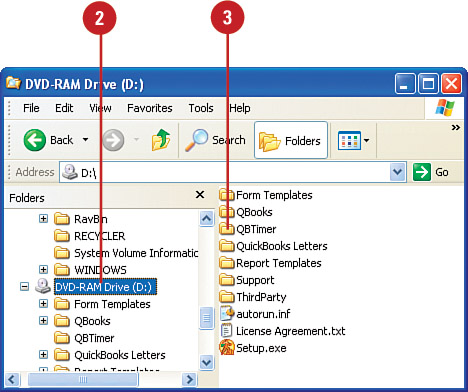
![]() Double-click the QBTimer folder.
Double-click the QBTimer folder.
![]() Double-click Setup.exe.
Double-click Setup.exe.
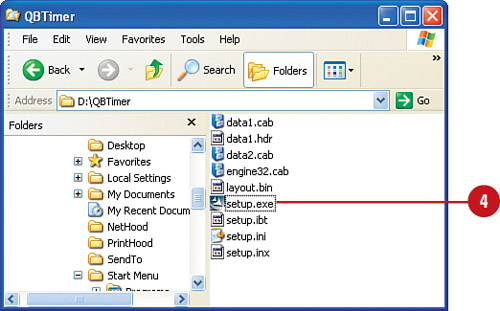
![]() Click Next on the QuickBooks Pro Timer Installation Wizard (not shown).
Click Next on the QuickBooks Pro Timer Installation Wizard (not shown).
![]() Follow the onscreen installation instructions, accepting the default choices for file locations and options and clicking Next and Install to continue through the installation process (not shown).
Follow the onscreen installation instructions, accepting the default choices for file locations and options and clicking Next and Install to continue through the installation process (not shown).
![]() For future reference, make a note of the name of the folder into which the timer is installed.
For future reference, make a note of the name of the folder into which the timer is installed.
Exporting Information to the Timer
The timer uses information from your QuickBooks file to enable your employees and contractors to charge time to customers and jobs. Employee names; descriptions of payroll items such as salary, hourly, overtime, and so on (not amounts, just the names of these items); names of customers and related jobs; and classes (if applicable) all are fed into the timer. Then an employee or a contractor simply uses the timer like a stop watch to record time spent on a project. The total time for the project can also be entered directly into the timer. This information must be exported to the timer before your employees or contractors can start using the timer.
![]() Open QuickBooks and select File, Utilities, Export, Timer Lists.
Open QuickBooks and select File, Utilities, Export, Timer Lists.
![]() You see a graphic illustration of how the timer works. Click OK.
You see a graphic illustration of how the timer works. Click OK.
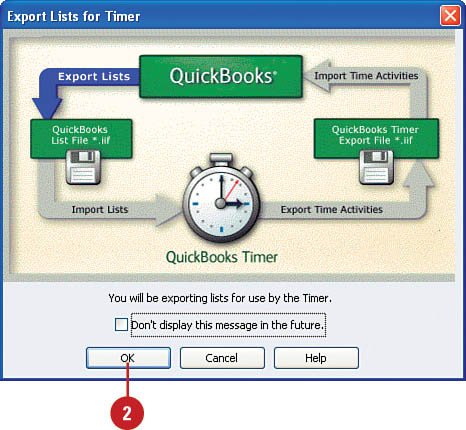
![]() Enter a filename for the timer file, preserving the
Enter a filename for the timer file, preserving the .IIF file extension QuickBooks supplies.
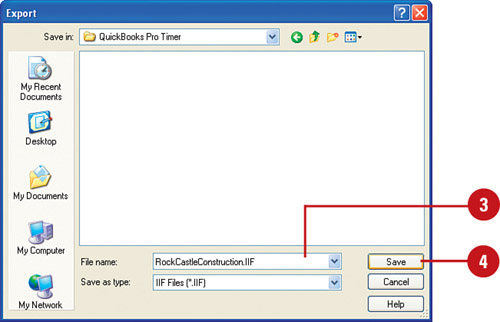
Important
You need to provide this file to others. Remember the folder where this file is saved because you will need to copy this file for any employees or contractors who are using the timer on another computer. Keep in mind that, in addition to those who use desktop models, employees and contractors using laptop computers can also take advantage of the timer feature.
![]() Click Save.
Click Save.
![]() Click OK.
Click OK.

Creating a New Timer File
When using the timer—whether it is on your computer, as illustrated here, or on someone else’s computer where you have installed the program—you don’t need to have your QuickBooks program open. The timer works independently of QuickBooks, which is why you can provide the timer to others who aren’t using your computer. You record time and activities in the timer and use the memo area to describe the work you do.
![]() Click the Start button; then select All Programs, QuickBooks Timer, QuickBooks Pro Timer.
Click the Start button; then select All Programs, QuickBooks Timer, QuickBooks Pro Timer.
![]() For this example, we will assume you haven’t used the timer before. Click Create New Timer File.
For this example, we will assume you haven’t used the timer before. Click Create New Timer File.

![]() Click OK.
Click OK.
![]() Give your timer file a name.
Give your timer file a name.
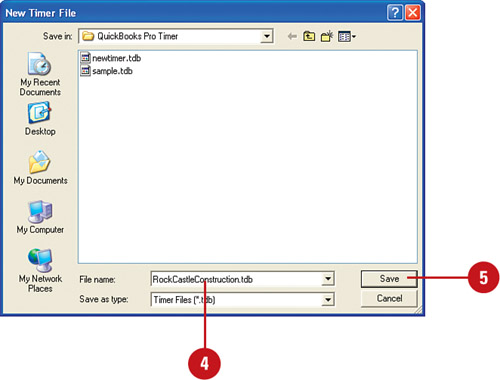
![]() Click Save.
Click Save.
![]() You are reminded that you need to import the timer information. Click No to continue to the import session.
You are reminded that you need to import the timer information. Click No to continue to the import session.

![]() In the Timer program, select File, Import QuickBooks Lists from the menu.
In the Timer program, select File, Import QuickBooks Lists from the menu.

![]() Click Continue on the Import QuickBooks Lists window.
Click Continue on the Import QuickBooks Lists window.
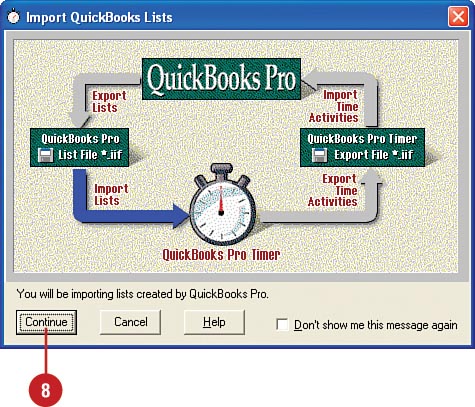
![]() Click on the filename where your timer data was exported from QuickBooks.
Click on the filename where your timer data was exported from QuickBooks.

![]() Click Open.
Click Open.
![]() Click OK.
Click OK.

Creating a Timer Activity
Before you can begin clocking your time, you must indicate the type of activity you are performing, the name of the customer or job to which this activity applies, and the class (if applicable). You might want to include a brief description of the exact work you are performing and indicate whether this time is directly billable to the customer. You don’t have to enter this information each time you use the timer for the same job. Once entered, the job information will be accessible in the future.
![]() With the timer open, click the New Activity button in the timer window.
With the timer open, click the New Activity button in the timer window.
![]() Enter the date. The timer defaults to today’s date; you might need to enter a different date, particularly if you are entering time for work that was performed at an earlier date.
Enter the date. The timer defaults to today’s date; you might need to enter a different date, particularly if you are entering time for work that was performed at an earlier date.
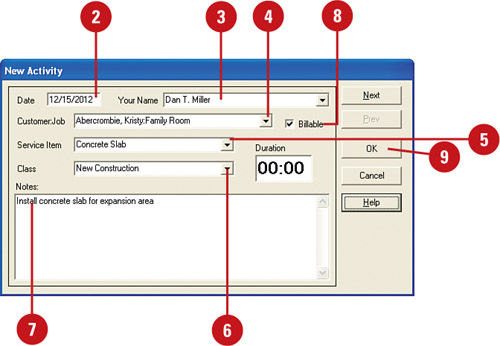
![]() Select your name (or the name of the person who is using the timer) from the drop-down menu.
Select your name (or the name of the person who is using the timer) from the drop-down menu.
![]() Select a customer and job from the Customer:Job drop-down menu.
Select a customer and job from the Customer:Job drop-down menu.
![]() Make a selection in the Service Item drop-down menu.
Make a selection in the Service Item drop-down menu.
![]() If your company uses classes, make a selection in the Class drop-down menu.
If your company uses classes, make a selection in the Class drop-down menu.
![]() Enter optional memorandum information that describes the work in the Notes field.
Enter optional memorandum information that describes the work in the Notes field.
![]() Indicate whether this time is to be billed to the customer by checking or unchecking the Billable box.
Indicate whether this time is to be billed to the customer by checking or unchecking the Billable box.
![]() Click OK.
Click OK.
![]() Repeat these steps to create more timed activities.
Repeat these steps to create more timed activities.
Using the Timer
After you’ve set up at least one timed activity in your timer, you can use the timer to record your time on the activity. You have the choice of actually using the timer as a stop watch or entering your total time for a project.
![]() Click the Start button on your taskbar. Then select Programs, QuickBooks Timer, QuickBooks Pro Timer.
Click the Start button on your taskbar. Then select Programs, QuickBooks Timer, QuickBooks Pro Timer.
![]() Select an activity from the Current Activity drop-down list.
Select an activity from the Current Activity drop-down list.

![]() Click Start and begin working.
Click Start and begin working.
![]() When you have finished working and are ready to stop the clock, click Stop.
When you have finished working and are ready to stop the clock, click Stop.
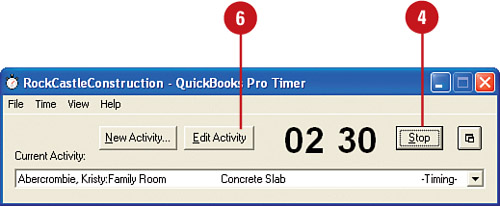
![]() The Stop button changes to Resume, and you can click Resume to continue running the timer.
The Stop button changes to Resume, and you can click Resume to continue running the timer.
![]() To enter your time directly into the timer instead of running the stop watch, click Edit Activity.
To enter your time directly into the timer instead of running the stop watch, click Edit Activity.
![]() Enter the correct time in the Duration field.
Enter the correct time in the Duration field.
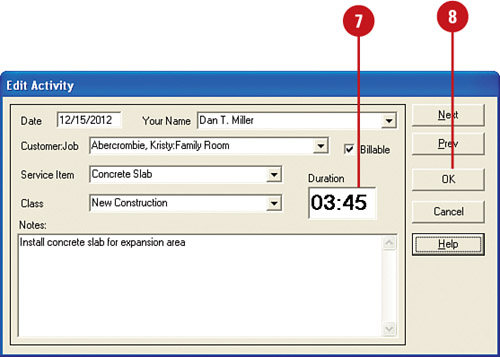
![]() Click OK.
Click OK.
![]() When you are finished recording your time, select File, Exit from the menu in the Timer program.
When you are finished recording your time, select File, Exit from the menu in the Timer program.
Sending Timer Data to QuickBooks
After recording information in the timer, you need to send the data back to be incorporated into your company’s QuickBooks file. This is a reverse of the export/import process you used when you sent employee and job data to the timer from QuickBooks. When timer data has been returned to QuickBooks, you can bill the time to clients and link it to the payroll program.
![]() In the Timer program, select File, Export Time Activities from the menu.
In the Timer program, select File, Export Time Activities from the menu.
![]() Click Continue.
Click Continue.

![]() Enter the date through which timer activities should be exported to QuickBooks.
Enter the date through which timer activities should be exported to QuickBooks.
![]() Click OK.
Click OK.

![]() Enter a filename for your export file. The user’s initials and date of the export have been used as the filename in this example.
Enter a filename for your export file. The user’s initials and date of the export have been used as the filename in this example.

![]() Click Save.
Click Save.
![]() Click OK.
Click OK.
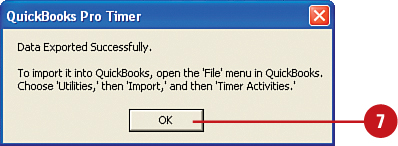
![]() You can now close the timer program.
You can now close the timer program.
Importing Timer Data into QuickBooks
QuickBooks imports data from the timer directly into the employee or subcontractor time sheets. After the data is imported, you can pay employees with the data from the timer and bill time to your customers.
![]() In your QuickBooks program, select File, Utilities, Import, Timer Activities.
In your QuickBooks program, select File, Utilities, Import, Timer Activities.
![]() Click OK.
Click OK.

![]() In the Import window that displays, locate and click the file.
In the Import window that displays, locate and click the file.

![]() Click Open.
Click Open.
![]() Click the name of the report you want to view.
Click the name of the report you want to view.
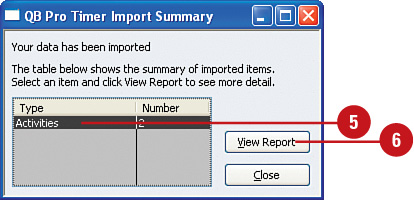
![]() Click View Report to see the details of the imported activities.
Click View Report to see the details of the imported activities.
![]() When the report displays, double-click any activity to see that the activity has been entered in the Time/Enter Single Activity window of your company’s payroll system.
When the report displays, double-click any activity to see that the activity has been entered in the Time/Enter Single Activity window of your company’s payroll system.
![]() Click the Timesheet button to view the complete time record for this employee.
Click the Timesheet button to view the complete time record for this employee.
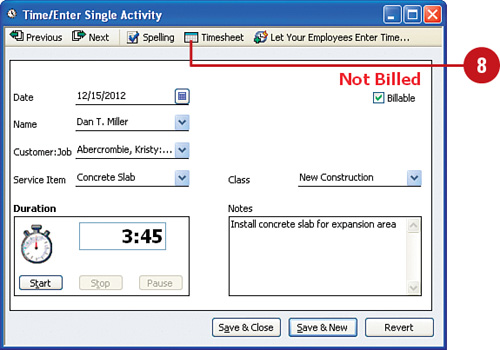
Transactions
In your timer program, you can view all the timer activities, even the ones that have been exported. This task shows you how to view timer transactions.
![]() With the timer open, select View, Time Activity Log from the menu.
With the timer open, select View, Time Activity Log from the menu.
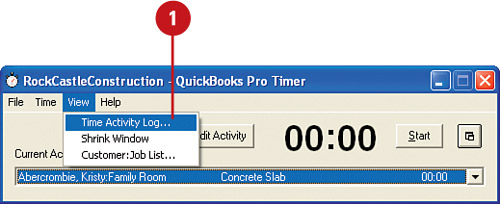
![]() Enter the date or date range for which you want to view timer activity.
Enter the date or date range for which you want to view timer activity.

![]() Note whether activities have been exported.
Note whether activities have been exported.
![]() Double-click any activity to open the activity and edit it (see the next task for an example of editing a timed activity).
Double-click any activity to open the activity and edit it (see the next task for an example of editing a timed activity).
![]() Click any activity once; then click the Contact Info button to view detailed contact information about the customer or client.
Click any activity once; then click the Contact Info button to view detailed contact information about the customer or client.
![]() Limit the number of timed activities that are exported to QuickBooks by holding down the Ctrl key while clicking to select certain activities in the log.
Limit the number of timed activities that are exported to QuickBooks by holding down the Ctrl key while clicking to select certain activities in the log.
![]() Click Export to export all selected activities.
Click Export to export all selected activities.
Editing Timer Transactions
You can change information that has been recorded in the timer by editing transactions. If the information has already been exported to QuickBooks, make sure you inform the QuickBooks administrator of the changes that need to be made so the exported information can be corrected.
![]() With the timer activity log open (see the previous task), double-click any timer activity to edit it.
With the timer activity log open (see the previous task), double-click any timer activity to edit it.
Important
If you attempt to edit a timer transaction that has previously been exported, you will receive an alert message advising you that the activity has already been exported. Click Yes to change the transaction’s status to Unexported, or click No to leave the status as Exported. Click Cancel if you have decided not to edit this transaction after all.
![]() Change the Customer:Job information if necessary.
Change the Customer:Job information if necessary.

![]() Adjust the amount of time if necessary.
Adjust the amount of time if necessary.
![]() Correct the detailed text description if necessary.
Correct the detailed text description if necessary.
![]() Click OK when you’ve finished making changes.
Click OK when you’ve finished making changes.
Invoicing the Customer for Timer Activities
When you enter time that is allocated to a customer or job in the timer, the information carries over directly to that customer when the time is imported into QuickBooks. See how to apply that time to a customer invoice.
![]() Import time from the timer, as shown in the task “Importing Timer Data to QuickBooks.”
Import time from the timer, as shown in the task “Importing Timer Data to QuickBooks.”
![]() Select Invoice for Time and Expenses from the Customers menu. (If you do not have this menu, skip to the next step.) Select a date range for costs you want to include on the invoice.
Select Invoice for Time and Expenses from the Customers menu. (If you do not have this menu, skip to the next step.) Select a date range for costs you want to include on the invoice.
![]() Select the customer you want to bill and click Create Invoice.
Select the customer you want to bill and click Create Invoice.
![]() Optionally select Let Me Select Specific Billables for This Client.
Optionally select Let Me Select Specific Billables for This Client.

![]() Click the Add Time/Costs tab.
Click the Add Time/Costs tab.
![]() Click to check each item you want to include on this invoice, or click Select All to choose all items.
Click to check each item you want to include on this invoice, or click Select All to choose all items.
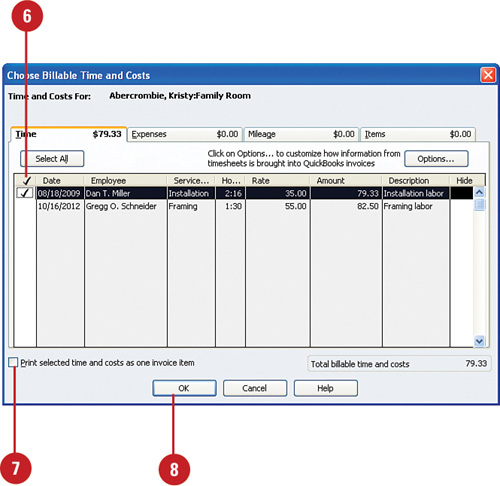
![]() Check the Print Selected Time and Costs as One Invoice Item box if you want all time to be displayed as one item on the invoice.
Check the Print Selected Time and Costs as One Invoice Item box if you want all time to be displayed as one item on the invoice.
![]() Click OK.
Click OK.
![]() Click one of the save buttons to save the invoice.
Click one of the save buttons to save the invoice.
